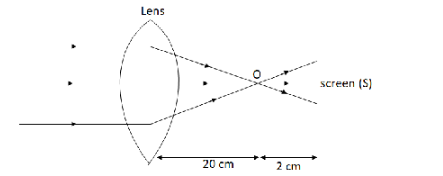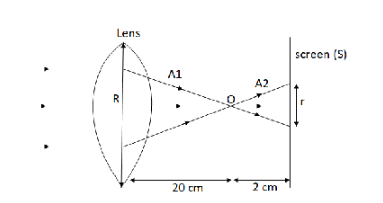Question
Question: Sunlight of intensity \[1.3\,{\text{kW}}{{\text{m}}^{{\text{ - 2}}}}\] is incident normally on a thi...
Sunlight of intensity 1.3kWm - 2 is incident normally on a thin convex lens of focal length 20cm. Ignore the energy loss of light due to the lens and assume that the lens aperture size is much smaller than its focal length. The average intensity of light, in kWm - 2, at a distance 22cm from the lens on the other side is _________.
Solution
This is a question of ray optics, so first draw a ray diagram with the given information and check where the rays after emerging from the lens would meet. In this question we will also have to use the properties of similar triangles and use the formula for intensity to find the required answer.
Complete step by step solution:
Given, intensity of sunlight, I=1.3kWm - 2
Focal length of convex lens, f=20cm
Distance at which the average intensity has to be found from the other side of the lens, d=22cm
We draw the ray diagram with the given conditions,

We know, rays from infinite distance or parallel to the optical axis fall on a converging lens, the emerging rays intersect at the focal point on the other side of the lens.
Here, the focal point on the other side is O.
The distance of the screen from the other side is d=22cm so distance of the screen from the focal point O will be d′=2cm.
Let R be the radius of the lens and r be the radius of the spot formed on the screen.
Now, let us redraw the figure

A1 is the triangle formed on the left side of the focal point and A2 is the triangle formed on the right side of focal length.
We can observe that the triangles A1 and A2 are similar triangles as, all their corresponding angles are congruent. We have one more property of similar triangle which says, their corresponding sides are proportional that is we can write for triangles A1 and
A2 ,
rR=d′d
Putting the values of d and d′, we get
rR=220
⇒rR=10 (i)
Intensity can be defined as energy per unit area, that is
I=areaEnergy
When the rays on sunlight incident on the lens, its intensity will be
I=AE
where E is the energy of sunlight and A is area of triangle A1, which is A=πR2.
Putting this value in above equation we get,
I=πR2E (ii)
The intensity on the screen will be (using the fact that there is no loss in energy so energy will be the same)
I′=A′E
where A′ is the area of triangle A2, which is A′=πr2. Putting this value in above equation we get,
I′=πr2E (iii)
Dividing equation (iii) by (ii), we get
II′=πr2E×EπR2
⇒I′=Ir2R2=I(rR)2
Putting the values of I and rR, we get
I′=1.3(10)2
⇒I′=130kWm - 2
Therefore, the average intensity of light at a distance of 22cm from the lens on the other side is 130kWm - 2.
Note: Whenever you have a question of ray optics, always draw a ray diagram with the information given in the question. And with the help of the diagram find the required quantity. Also remember rays from infinite distance are considered as parallel rays, this is because as the distance between the source and the lens or mirror increases, the angle between rays from a distance source approaches zero.
